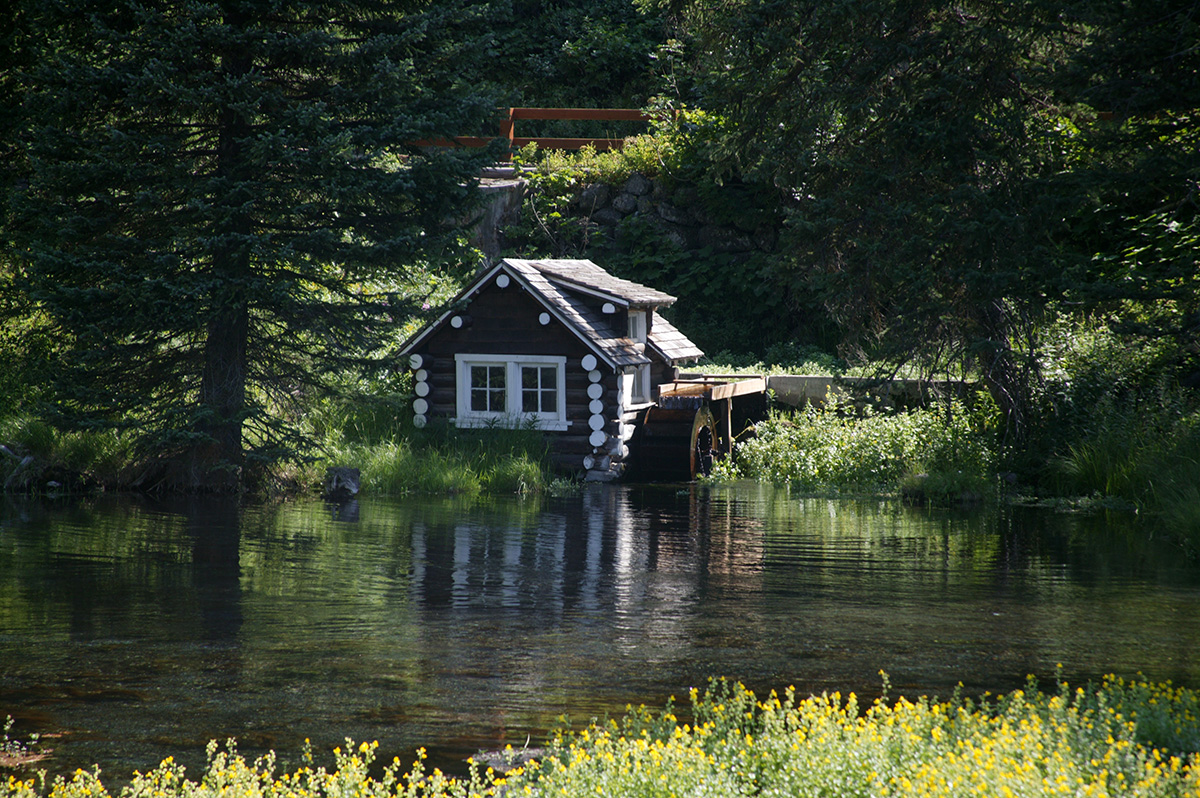Information
 Johnny Sack’s Cabin is located at Big Springs, five miles east of Mack’s Inn on Highway 20 in Island Park, Idaho. The cabin can be reached via a short, paved walking path starting in the campground at Big Springs. The cabin’s unique location, contruction, and furnishings provide for an interesting visit.
Johnny Sack’s Cabin is located at Big Springs, five miles east of Mack’s Inn on Highway 20 in Island Park, Idaho. The cabin can be reached via a short, paved walking path starting in the campground at Big Springs. The cabin’s unique location, contruction, and furnishings provide for an interesting visit.
 Johnny Sack, a German cabinet maker, came to the United States in his 20’s. In 1929, he leased a small tract of land at Big Springs from the Forest Service. The cabin was started in 1932 and completed three years later. Even though he was a bachelor all his life, he had many friends and visitors.Consequently, he added on to the house over the years.
Johnny Sack, a German cabinet maker, came to the United States in his 20’s. In 1929, he leased a small tract of land at Big Springs from the Forest Service. The cabin was started in 1932 and completed three years later. Even though he was a bachelor all his life, he had many friends and visitors.Consequently, he added on to the house over the years.
What makes the craftmanship of Johnny Sack unique is the use of bark in the details of the house and his furniture. Through careful preparation of the lumber, the bark remains on the wood, providing a creative texture and color to the trim of windows, wall panels, ceiling lamps, chairs, desks, beds, and other wooden items.
 John Sack was only 4 feet 11 inches tall. While most of the house has typical ceilings, his work area in the
John Sack was only 4 feet 11 inches tall. While most of the house has typical ceilings, his work area in the
basement reflects his small statue. In the winter he would move his work area in front of the fire place on the main floor.
After Johnny’s death in 1957, the cabin was to be removed along with all the other private Cabins in the area. Through the efforts of interested citizens, the cabin and its colorful history was preserved. The cabin is maintained by a local non profit organization.
Directions:
Big Springs area / Eastern Idaho, Island Park – 5 miles E. of Mack’s Inn
Nearest City:
Island Park
Mailing Address:
Box 858
46 Highway 20
Ashton ID, 83420
Contact:
(208) 652-7442
Send an Email: dcikaitoga@fs.fed.us
Attraction Type(s):
•Historic Sites
•Tours
Seasons:
Summer
Hours: Mid-June thru Labor Day, 10AM – 4PM.
Fees: Donations
Facilities: Parking, Vault Toilets




IDAHO STATE HISTORICAL SOCIETY ~ REFERENCE SERIES ~
JOHNNY SACK’S CABIN ~ Number 957 July 1979 ~ SIGNIFICANCE
The Johnny Sack cabin is architecturally and artistically significant for its distinctive craftsmanship. It is widely recognized locally as a landmark, and generally acknowledged to be the finest building in the Big Springs area of Island Park. It is considered to be the work of a master craftsman, and concern for its preservation has been expressed locally by the Madison County Historical Society. As an example of the bungalow mode applied to log construction the Sack cabin has more than local significance, however, and should be preserved.
The Johnny Sack cabin is a typical vacation house of the period 1920 to 1950. During this period the use of the log cabin motif became popular among rusticating Idahoans seeking peace and tranquility in the sylvan confines of Idaho’s mountain regions. The Sack cabin, with its exquisite craftsmanship, is one of the more remarkable examples of its genre encountered in our state site survey to date.
The log cabin motif with its associations with rustic life became a prime symbol of the roughing holiday seeker as the actualities of pioneer life retreated into the realm of nostalgia. The Island Park area developed as a rather exclusive vacation area as the Railroad Ranch, owned by the Guggenheims and Harrimans, is a part of the region. The Big Springs region of the park, where the Johnny Sack cabin is located, was designated as part of the Federal Forest Reserve in 1906. In the early 1920’s land was leased to the Kooch family and a resort inn was built. Later, in the 1930’s more land was opened up to the public and it was at this time that the Sack cabin was erected on lease land. The cabin is the most pretentious of the cabins on Big Springs and is picturesquely located on a point overlooking the lake.
PHYSICAL APPEARANCE
The Johnny Sack cabin is an exceptionally well made log bungalow, approximately 20 x 27 feet in size, with additions in the form of porches for sleeping and entry. Two bedrooms on the second story are made possible by a shed dormer extension to the east. Native stone, laid in random pattern, is used for piers 957 2
and foundations of the enclosed entry porch. The stone is chiefly of granite material in pink and several shades of grey.


The wooden window sashes employed are varied in size and construction. Most are fixed. Second story end windows are of the sliding variety.
The shapes and overall character of the cabin seem to derive from the prevailing bungalow mode of the period of construction (1932-1934) rather than from German models which may have been known to its immigrant builder, Johnny Sack. The roof pitch, extended eaves, exposed rafters, and chopped gables are all typical bungalow features which can be seen in most small towns in Idaho.
The craftsmanship in wood displayed in the house, especially in interior finish and hand-made furniture, is notable. A planed-bark technique is employed which creates rich and pleasing surface patterns.
Prepared by Arthur A. Hart
(This information has not been edited.)
Publications–450 N. 4th Street, Boise, ID 83702–208-334-3428







